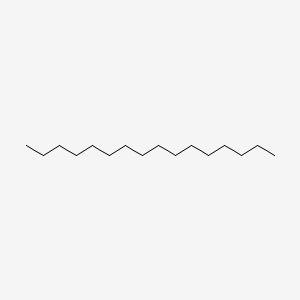| MeSH term | MeSH ID | Detail |
|---|---|---|
| Lupus Erythematosus, Systemic | D008180 | 43 associated lipids |
| Body Weight | D001835 | 333 associated lipids |
| Coronary Disease | D003327 | 70 associated lipids |
| Peritonitis | D010538 | 38 associated lipids |
| Hyperplasia | D006965 | 34 associated lipids |
| Glomerulonephritis | D005921 | 35 associated lipids |
| Encephalomyelitis, Autoimmune, Experimental | D004681 | 26 associated lipids |
| Keratosis | D007642 | 9 associated lipids |
| Serratia Infections | D016868 | 2 associated lipids |
Hexadecane
Hexadecane is a lipid of Fatty Acyls (FA) class. The involved functions are known as Analyte. The related lipids are Fatty Acids and palmitoleic acid.
Cross Reference
Introduction
To understand associated biological information of Hexadecane, we collected biological information of abnormalities, associated pathways, cellular/molecular locations, biological functions, related genes/proteins, lipids and common seen animal/experimental models with organized paragraphs from literatures.
What diseases are associated with Hexadecane?
There are no associated biomedical information in the current reference collection.
Possible diseases from mapped MeSH terms on references
We collected disease MeSH terms mapped to the references associated with Hexadecane
PubChem Associated disorders and diseases
What pathways are associated with Hexadecane
There are no associated biomedical information in the current reference collection.
PubChem Biomolecular Interactions and Pathways
Link to PubChem Biomolecular Interactions and PathwaysWhat cellular locations are associated with Hexadecane?
There are no associated biomedical information in the current reference collection.
What functions are associated with Hexadecane?
Related references are published most in these journals:
| Function | Cross reference | Weighted score | Related literatures |
|---|
What lipids are associated with Hexadecane?
Related references are published most in these journals:
| Lipid concept | Cross reference | Weighted score | Related literatures |
|---|
What genes are associated with Hexadecane?
There are no associated biomedical information in the current reference collection.
What common seen animal models are associated with Hexadecane?
There are no associated biomedical information in the current reference collection.
NCBI Entrez Crosslinks
All references with Hexadecane
Download all related citations| Authors | Title | Published | Journal | PubMed Link |
|---|---|---|---|---|
| van der Mei HC et al. | Adhesion of coagulase-negative staphylococci grouped according to physico-chemical surface properties. | 1997 | Microbiology (Reading, Engl.) | pmid:9421910 |
| Wyatt JE et al. | Lack of correlation between fibrils, hydrophobicity and adhesion for strains of Streptococcus sanguis biotypes I and II. | 1987 | Microbios | pmid:2885724 |
| Eaves DJ and Doyle RJ | Surface characteristics of Pseudomonas cepacia. | 1988 | Microbios | pmid:3374397 |
| Miyake Y et al. | Surface hydrophobicity and adherence of Candida to acrylic surfaces. | 1986 | Microbios | pmid:3526098 |
| Cuperus PL et al. | Effects of ciprofloxacin and vancomycin on physicochemical surface properties of Staphylococcus epidermidis, Escherichia coli, Lactobacillus casei and Lactobacillus acidophilus. | 1995 | Microbios | pmid:7791631 |
| Bilai VI et al. | [Formation of fatty acids by aspergillus ochraceus 15B growing on a hexadecane containing medium]. | 1975 Mar-Apr | Mikrobiol Zh | pmid:1214637 |
| Pyroh TP et al. | [Peculiarities of surface-active trehalose mycolates synthesis of Rhodococcus erythropolis EK-1]. | 2010 Mar-Apr | Mikrobiol. Z. | pmid:20455436 |
| Pirog TP et al. | [Synthesis of surfactants acinetobacter calcoaceticus IMV B-7241 and Rhodococcus erythropolis IMV Ac-5070 in the medium with glycerol]. | 2012 Jan-Feb | Mikrobiol. Z. | pmid:22545440 |
| Pyroh TP et al. | [Effect of citric acid on synthesis of surfactants in Rhodococcus erythropolis IMV Ac-5017]. | 2011 Sep-Oct | Mikrobiol. Z. | pmid:22164696 |
| Pirog TP et al. | [Effect of Cu2+ on synthesis of biosurfactants of Acinetobacter calcoaceticus IMV B-7241 and Rhodococcus erythropolis IMV Ac-5017]. | 2013 Jan-Feb | Mikrobiol. Z. | pmid:23516834 |
